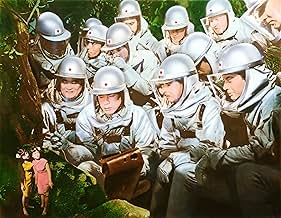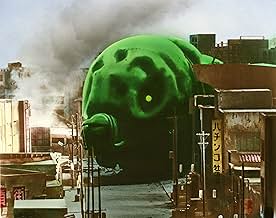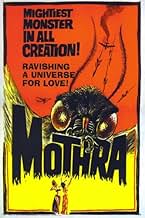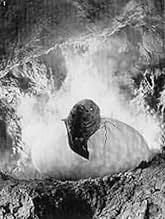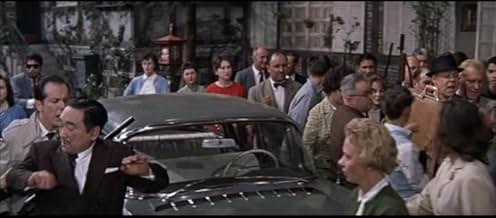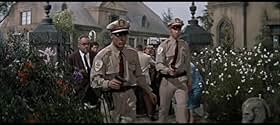अपनी भाषा में प्लॉट जोड़ेंAn expedition to Infant Island uncovers a native tribe and twin tiny fairy priestesses of a mythical deity, who sets out to rescue the pair after they are kidnapped by a greedy businessman.An expedition to Infant Island uncovers a native tribe and twin tiny fairy priestesses of a mythical deity, who sets out to rescue the pair after they are kidnapped by a greedy businessman.An expedition to Infant Island uncovers a native tribe and twin tiny fairy priestesses of a mythical deity, who sets out to rescue the pair after they are kidnapped by a greedy businessman.
- पुरस्कार
- 2 कुल नामांकन
- Shobijin (Twin Fairy)
- (as Yumi Ito)
- Shobijin (Twin Fairy)
- (as Emi Ito)
- Kurâruku Neruson
- (as Jerî Itô)
- Military Advisor
- (as Yoshibumi Tajima)
- Nelson's Henchman
- (as Hiroshi Iwamoto)
- Ship Survivor
- (काटे गए सीन)
फ़ीचर्ड समीक्षाएं
Mothra is a sympathetic character which became popular and went on to co-star in many more Toho adventures. The female creature starts out as a gigantic crawling caterpillar, but late in the movie emerges out of its self-spun cocoon, as a huge and colorful flying moth that causes intense catastrophic winds when flapping its wings. Jerry Ito is a perfect hateful lead villain, but he is counterbalanced partly by the agreeable presence of comedian Frankie Sakai on the side of the good guys. The story is involving, and the pacing very comfortable. I have always been a big fan of the charming little song that the twin fairies sing in honor of their savior, Mothra. The English language version is well dubbed, and there are some differences between the U.S. and original Japanese versions; but either one is good and enjoyable.
*** out of ****
Nothing much to say about this one. I only knew Mothra as an adversary to Godzilla and was interested in seeing the film where he debuts and predates his epic fight with the lizard of destruction. It is a good story and gets to the heart of the Mothra myth with the singing fairies that summon him.
While maybe not as iconic as Godzilla, Mothra is a kaiju worthy of his own film series (which he has), and those interested in Toho's work really ought to check it out.
Here we see the debut of Mothra getting her own film, a character who would go onto be one of the most commonly seen creatures.
It tells the story of a rich businessman who kidnaps two tiny ladies from their native land to use in show business. In doing so Mothra was summoned to retrieve them using any means necessary even if it means the entire destruction of Tokyo in the process.
Mothra actually looks good for it's day, there is no man in a goofy suit as usual and Mothra in both infant and adult forms look far better than you'd expect.
The cast are less generic than usual, the lead is fairly comedic and the whole thing feels above average within this original kaiju film.
Certainly one of the better films of the series that I've seen thus far, but still highly niche.
The Good:
Some of the sfx are quite good for their day
Character development is better than usual
The Bad:
Still highly cheesy
A few weak points in the plot
Things I Learnt From This Movie:
Stowaways are not only not punished but they are given guns
A gigantic monster worm in a coccoon isn't newsworthy
The transitional phase for giant moths is a peanut
The colors are bright. The story is strange. Mothra doesn't appear until halfway through the movie. The tiny singers are the strangest cinematic creations and that's in the same movie as Mothra. There is a lot of miniature and green screen work. This is a classic Japanese monster movie.
क्या आपको पता है
- ट्रिवियाThe Mothra larva was the largest costume Toho would create in the Showa era. The Mothra larva seen rampaging through Tokyo's neighborhood was about 7 feet tall and just over 31 feet long. Weighing about 265 pounds (120 kilograms), a total of eight actors were needed to perform and operate the Mothra larva.
- गूफ़When Dr. Shinichi is showing the symbols he discovered in the cave to Senchan, you can see someone in black pants and shoes walking down the stairs behind Senchan's head.
- भाव
[the protagonists confront Nelson to return Mothra's fairies back to Infant Island]
Dr. Shinichi Chujo: I want you to stop this inhumanity and return them to their island.
Nelson's Henchman: Inhumanity? Ridiculous. Strictly speaking they're just scientific data.
Clark Nelson: Those fairies aren't human. They're merchandise.
- क्रेज़ी क्रेडिटIn the credits for the U.S. version, including promo material released by Columbia Pictures, Eurasian model Jerry Ito (who plays the villianous Mr. Nelson) is billed as "Jelly Ito."
- इसके अलावा अन्य वर्जनThe American Version also edited the birth of Mothra sequence, cutting out a good 40 seconds to make it more elaborate
- कनेक्शनEdited into Godzilla vs. Monster Zero (1965)
टॉप पसंद
विवरण
बॉक्स ऑफ़िस
- दुनिया भर में सकल
- $90
- चलने की अवधि
- 1 घं 41 मि(101 min)
- ध्वनि मिश्रण
- पक्ष अनुपात
- 2.35 : 1



